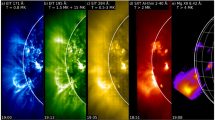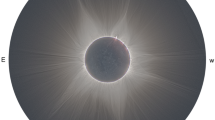Abstract
The magnetic flux longitudinal distribution in the equatorial solar zone has been studied. The magnetic synoptic maps of the Wilcox Solar Observatory (WSO) during Carrington rotations (CRs) 2052–2068 in 2007 and early 2008 have been analyzed. The longitudinal distributions of the area of the zones where the photospheric magnetic field locally enhanced have been constructed for each CR. The obtained distributions indicate that the zones are located discretely and that a clearly defined one narrow longitudinal interval with the maximum flux is present. The longitudinal position of this maximum shifted discretely by ≈130° at an interval of 5.5 ± 0.5 CRs. A longitudinal shift of the zones with an increased magnetic flux multiple of 60° was observed between the hemispheres. In addition, a time shift of ≈2.5 CRs existed between the instants when the position of maximum fluxes in different hemispheres shifted. The established peculiarities of the magnetic flux longitudinal distribution and time dynamics are interpreted as an action of supergiant convection cells. These actions result in that magnetic fields are removed from the generation region through the channels that are formed between such cells at a longitudinal interval of 120°. The average synodic rotation velocity of the considered equatorial channels, through which the magnetic flux emerges, is 13.43° day–1.
Similar content being viewed by others
References
Gnevyshev, M.N., The eleven-year cycle of solar activity, Phys.-Usp., 1967, vol. 9, no. 5, pp. 752–758.
Kosovichev, A.G., Probing plasma properties and dynamics inside the sun, Adv. Space Res., 2006, vol. 37, no. 8, pp. 1455–1466.
Merzlyakov, V.L. and Starkova, L.I., Sources of large-scale magnetic field of the corona in the period of low activity of the Sun, in Trudy Vserossiiskoi konferentsii “Solnechnaya i solnechno-zemnaya fizika-2013” (Proceedings of the All-Russian Conference “Solar and Solar–Terrestrial Physics-2013”), St. Petersburg: GAO RAN, 2013, pp. 141–144.
Merzlyakov, V.L. and Starkova, L.I., The longitudinal inhomogeneity of the solar toroidal magnetic field generation, Geomagn. Aeron. (Engl. Transl.), 2015, vol. 55, no. 8, pp. 1066–1070.
Yazev, S.A., Fenomen kompleksov aktivnosti na Solntse (The Phenomenon of Activity Complexes on the Sun), Irkutsk: IGU, 2014.
Zolotova, N.V. and Ponyavin, D.I., Impulse-like behavior of the sunspot activity, Astron. Rep., 2012, vol. 56, no. 3, pp. 250–255.
Author information
Authors and Affiliations
Corresponding author
Rights and permissions
About this article
Cite this article
Merzlyakov, V.L., Starkova, L.I. Peculiarities of the magnetic flux emerging in the equatorial solar zone. Geomagn. Aeron. 56, 1036–1039 (2016). https://doi.org/10.1134/S0016793216080156
Received:
Accepted:
Published:
Issue Date:
DOI: https://doi.org/10.1134/S0016793216080156




